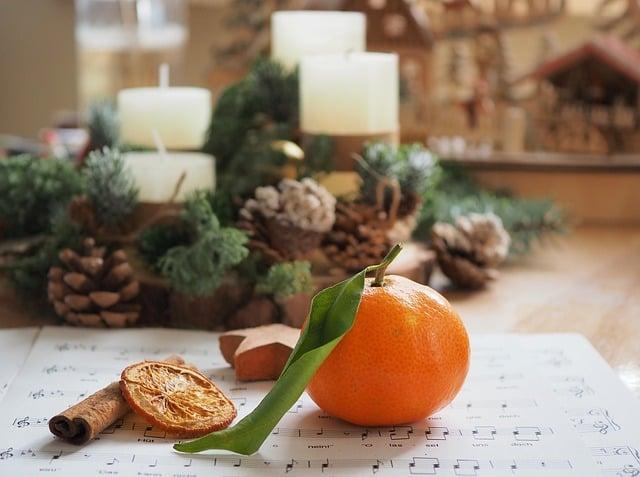Once upon a time in a quaint village, the first snowflakes began to fall, signaling the arrival of December. A kind-hearted baker named Elara decided to create something special for the children. She crafted a wooden calendar adorned with tiny doors, each hiding a sweet treat or a small toy. Each day, the children would gather, their eyes sparkling with anticipation, as they opened a door, counting down to the joyous celebration of Christmas. This simple act of daily discovery transformed the month into a magical journey, uniting the village in shared excitement and wonder.
Table of Contents
- The Historical Roots of Advent Calendars
- Exploring the Symbolism Behind Each Door
- Creative Variations for Modern Celebrations
- Tips for Crafting Your Own Advent Calendar Experience
- Q&A

The Historical Roots of Advent Calendars
The tradition of Advent calendars can be traced back to the early 19th century in Germany, where families would mark the days of Advent leading up to Christmas with simple chalk marks on doors or by lighting candles. This practice was a way to build anticipation for the festive season, allowing families to reflect on the spiritual significance of the days leading up to Christmas. As the custom evolved, the first printed Advent calendars emerged in the early 1900s, featuring illustrations and small doors that could be opened to reveal images or messages, further enhancing the excitement of the countdown.
By the mid-20th century, Advent calendars began to take on a more commercial aspect, with the introduction of chocolate-filled doors and various themes appealing to children and families alike. Today, these calendars come in a myriad of designs, from traditional religious motifs to modern pop culture references. Some common features include:
- Daily Surprises: Each day reveals a new treat or message, fostering a sense of joy and anticipation.
- Variety of Themes: Ranging from classic nativity scenes to whimsical characters, catering to diverse tastes.
- Interactive Elements: Many calendars now include activities or challenges, making the countdown more engaging.

Exploring the Symbolism Behind Each Door
Each door of an Advent calendar serves as a portal to a unique experience, rich with symbolism and meaning. Behind every door lies a small gift or treat, often representing the anticipation and joy of the holiday season. This tradition can be seen as a countdown to a significant event, with each opening symbolizing a step closer to the celebration of Christmas. The doors themselves can be viewed as barriers that, once opened, reveal the warmth of community, family, and the spirit of giving. The act of unveiling a new surprise each day fosters a sense of excitement and wonder, reminiscent of childhood innocence and the magic of the season.
Moreover, the design of each door can carry its own significance, reflecting various themes and values associated with the holiday. For instance, some doors may feature religious symbols, emphasizing the spiritual aspect of Christmas, while others might showcase festive imagery that highlights the joy of togetherness. The diversity in designs allows for a personal connection, as individuals may resonate with different symbols based on their own experiences and beliefs. This multifaceted approach not only enriches the Advent experience but also encourages reflection on the deeper meanings of the season, inviting us to explore our own traditions and the stories we share with loved ones.

Creative Variations for Modern Celebrations
Advent calendars have evolved far beyond their traditional chocolate-filled origins, embracing a myriad of creative interpretations that cater to modern tastes and preferences. Today, you can find calendars filled with everything from artisanal teas and gourmet snacks to beauty products and handmade crafts. This transformation allows individuals to personalize their countdown to the holidays, making each day a delightful surprise. Some even opt for DIY versions, where they can curate their own selection of treats or small gifts, adding a personal touch that reflects their unique style and interests.
Moreover, the concept of an Advent calendar has expanded into digital realms, with apps and online platforms offering interactive experiences. These modern adaptations can include daily challenges, virtual gifts, or even charitable donations, encouraging users to engage in acts of kindness throughout the season. As families and friends seek to create meaningful connections, these innovative calendars serve as a reminder to celebrate not just the days leading up to the holiday, but also the spirit of giving and togetherness. The possibilities are endless, making the Advent calendar a versatile and cherished tradition for contemporary celebrations.

Tips for Crafting Your Own Advent Calendar Experience
Creating a personalized Advent calendar can be a delightful way to count down to the holidays while adding a unique touch to your celebrations. Start by selecting a theme that resonates with you or your family—this could be anything from favorite holiday movies to cherished memories. Once you have a theme, gather small items or treats that align with it. Consider including:
- Handwritten notes with holiday wishes or memories
- Miniature gifts like ornaments or trinkets
- Homemade treats such as cookies or candies
- Activities like movie nights or crafting sessions
Next, think about the presentation of your calendar. You can repurpose small boxes, envelopes, or even cloth bags to house each day’s surprise. For a more interactive experience, consider creating a scavenger hunt where each clue leads to the next day’s item. This adds an element of fun and anticipation. Don’t forget to involve family members in the process—whether it’s choosing items or decorating the calendar itself, collaboration can enhance the joy of the season.
Q&A
-
What is an Advent calendar?
An Advent calendar is a special calendar used to count down the days of Advent, the period leading up to Christmas. Traditionally, it starts on December 1st and ends on December 24th, with each day revealing a small gift, treat, or message.
-
What is the origin of the Advent calendar?
The Advent calendar has its roots in 19th-century Germany, where families would mark the days of Advent with chalk on doors or by lighting candles. The first printed Advent calendar appeared in the early 1900s, evolving into the decorative versions we see today.
-
What types of Advent calendars are available?
Advent calendars come in various forms, including:
- Traditional paper calendars with doors to open
- Wooden calendars with reusable compartments
- Chocolate-filled calendars
- Calendars featuring toys, beauty products, or other themed items
-
How do you use an Advent calendar?
To use an Advent calendar, simply open one compartment each day, starting from December 1st. Each compartment typically contains a small surprise, allowing you to enjoy the anticipation of Christmas as you count down the days.
As the days of December unfold, the Advent calendar invites us to pause and reflect on the anticipation of the season. Whether filled with treats or thoughtful messages, it serves as a daily reminder of joy, hope, and the magic of waiting.

大家好,我是彼得潘,專業的手法身體治療師。我喜歡探索和研究各種主題,並透過與人工智慧的合作分享專業、實用、有趣的文章。我們定期進行人工審核,以確保內容的準確性。如果您發現文章中有任何不準確的地方,請隨時與我們聯繫,我們會及時糾正。您可以透過 [email protected] 與我們聯繫。



